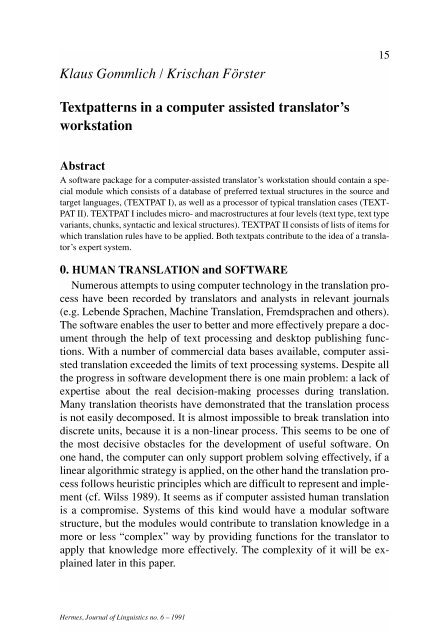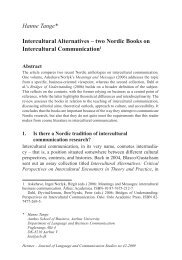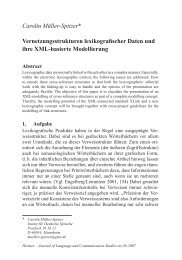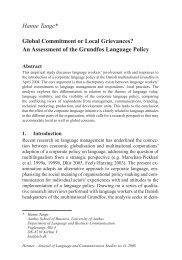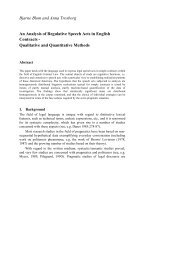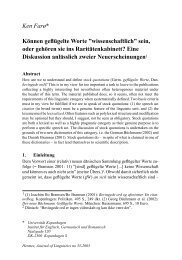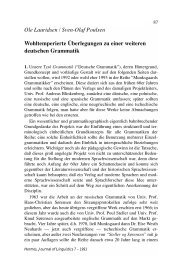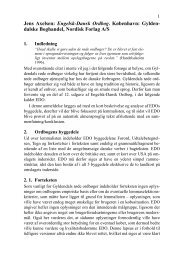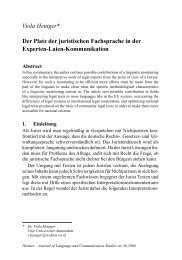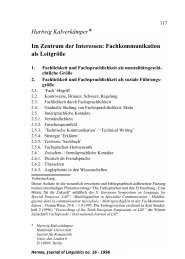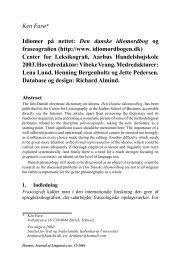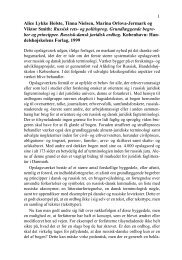Klaus Gommlich / Krischan Förster Textpatterns in a computer ...
Klaus Gommlich / Krischan Förster Textpatterns in a computer ...
Klaus Gommlich / Krischan Förster Textpatterns in a computer ...
You also want an ePaper? Increase the reach of your titles
YUMPU automatically turns print PDFs into web optimized ePapers that Google loves.
<strong>Klaus</strong> <strong>Gommlich</strong> / <strong>Krischan</strong> <strong>Förster</strong><br />
<strong>Textpatterns</strong> <strong>in</strong> a <strong>computer</strong> assisted translator’s<br />
workstation<br />
Abstract<br />
A software package for a <strong>computer</strong>-assisted translator’s workstation should conta<strong>in</strong> a special<br />
module which consists of a database of preferred textual structures <strong>in</strong> the source and<br />
target languages, (TEXTPAT I), as well as a processor of typical translation cases (TEXT-<br />
PAT II). TEXTPAT I <strong>in</strong>cludes micro- and macrostructures at four levels (text type, text type<br />
variants, chunks, syntactic and lexical structures). TEXTPAT II consists of lists of items for<br />
which translation rules have to be applied. Both textpats contribute to the idea of a translator’s<br />
expert system.<br />
0. HUMAN TRANSLATION and SOFTWARE<br />
Numerous attempts to us<strong>in</strong>g <strong>computer</strong> technology <strong>in</strong> the translation process<br />
have been recorded by translators and analysts <strong>in</strong> relevant journals<br />
(e.g. Lebende Sprachen, Mach<strong>in</strong>e Translation, Fremdsprachen and others).<br />
The software enables the user to better and more effectively prepare a document<br />
through the help of text process<strong>in</strong>g and desktop publish<strong>in</strong>g functions.<br />
With a number of commercial data bases available, <strong>computer</strong> assisted<br />
translation exceeded the limits of text process<strong>in</strong>g systems. Despite all<br />
the progress <strong>in</strong> software development there is one ma<strong>in</strong> problem: a lack of<br />
expertise about the real decision-mak<strong>in</strong>g processes dur<strong>in</strong>g translation.<br />
Many translation theorists have demonstrated that the translation process<br />
is not easily decomposed. It is almost impossible to break translation <strong>in</strong>to<br />
discrete units, because it is a non-l<strong>in</strong>ear process. This seems to be one of<br />
the most decisive obstacles for the development of useful software. On<br />
one hand, the <strong>computer</strong> can only support problem solv<strong>in</strong>g effectively, if a<br />
l<strong>in</strong>ear algorithmic strategy is applied, on the other hand the translation process<br />
follows heuristic pr<strong>in</strong>ciples which are difficult to represent and implement<br />
(cf. Wilss 1989). It seems as if <strong>computer</strong> assisted human translation<br />
is a compromise. Systems of this k<strong>in</strong>d would have a modular software<br />
structure, but the modules would contribute to translation knowledge <strong>in</strong> a<br />
more or less “complex” way by provid<strong>in</strong>g functions for the translator to<br />
apply that knowledge more effectively. The complexity of it will be expla<strong>in</strong>ed<br />
later <strong>in</strong> this paper.<br />
Hermes, Journal of L<strong>in</strong>guistics no. 6 – 1991<br />
15
16<br />
To put it bluntly, a <strong>computer</strong> assisted translator’s workstation should<br />
offer <strong>in</strong>formation to the translator and assist him <strong>in</strong> carry<strong>in</strong>g out the technical<br />
tasks of translations (cf. Tong 1987, Freigang 1988). At this stage, the<br />
translator’s rout<strong>in</strong>e work is the focus of the workstation’s modules and not<br />
his creative activities. Based on these preconditions the modules to be put<br />
together <strong>in</strong> a software package are the follow<strong>in</strong>g: automatic dictionary, automatic<br />
lemmatization, textpatterns, and the text processor. Integrat<strong>in</strong>g<br />
these four basic modules <strong>in</strong> an automatic translator’s assistant system will<br />
be a difficult problem. No suitable software package has been developed<br />
yet and translators use several partial solutions. A new technology that<br />
might be applied to the problem is HYPERTEXT, the non-l<strong>in</strong>ear text (cf.<br />
Conkl<strong>in</strong> 1981, Neubert 1990, Shreve/Scherf/ V<strong>in</strong>ciquerra 1990).<br />
1. TEXTPATTERNS — Reasons and Feasibility<br />
Of the four modules of an <strong>in</strong>tegrated automatic translator’s assistant system,<br />
we will focus on textpatterns here. They are the result of apply<strong>in</strong>g<br />
textl<strong>in</strong>guistic f<strong>in</strong>d<strong>in</strong>gs to the translation process. The diversity and identity<br />
of the structures of source language (SL) and target language (TL) texts determ<strong>in</strong>es<br />
the design of the textpattern module. Its ma<strong>in</strong> aim is to make the<br />
translator aware of textual structures on different levels of his SL- and TLtexts.<br />
These correspond to process<strong>in</strong>g levels which could be accessed<br />
whenever requested. The orig<strong>in</strong>al idea of a textpattern is to store textual<br />
<strong>in</strong>formation <strong>in</strong> a “text-dictionary” or “textlexicon” as a mechanism to help<br />
process a translation (cf. Neubert 1968, 1973, <strong>Gommlich</strong> 1987). The textpattern<br />
should be composed of two basic data bases: (i) text structures <strong>in</strong><br />
source and/or target language <strong>in</strong> several textual levels and (ii) assignment<br />
rules for the SL and TL structures. The two data bases are related because<br />
both are generated by results of empirical comparative studies. The ma<strong>in</strong><br />
difference, however, is the character of the assignments. In fact, part of<br />
their content comes from SL and TL comparisons, but part of it reflects generalizations<br />
about the results of good translations (cf. <strong>Gommlich</strong>/Bohm/<br />
Zachert 1988).<br />
1.1 TEXTPAT I<br />
The TEXTPAT I data base conta<strong>in</strong>s an <strong>in</strong>ventory of text structures on different<br />
textual levels. It is based on the premise that the translation process<br />
is determ<strong>in</strong>ed both by the situational/pragmatic conditions under which<br />
the translation is carried out and by the <strong>in</strong>ternal structure of a text which<br />
f<strong>in</strong>d its expression <strong>in</strong> specific l<strong>in</strong>guistic means.
It is known that the translation of a text largely depends on its textual<br />
parameters (situationality, <strong>in</strong>tentionality, acceptability, <strong>in</strong>formativity, coherence,<br />
cohesion and <strong>in</strong>tertextuality — cf. Beaugrande/Dressler 1981,<br />
Neubert 1985). These parameters reflect the questions: what by who to<br />
whom, when, where, and for what purpose. These determ<strong>in</strong>ant factors <strong>in</strong>fluence<br />
both the decod<strong>in</strong>g and recod<strong>in</strong>g process. In understand<strong>in</strong>g the SLtext<br />
the translator analyzes the sequential and hierarchical structure, while<br />
consider<strong>in</strong>g the set of communicative factors. The result of analyz<strong>in</strong>g the<br />
SL-text is a text mean<strong>in</strong>g which is to be reconstructed <strong>in</strong> a TL-text. This is<br />
done with regard to the communicative sett<strong>in</strong>g which may or may not be<br />
identical with the SL-sett<strong>in</strong>g. If we accept a textual model of sequences<br />
and hierarchies, this entails the possible recurrence of structures. An analysis<br />
of a representative text corpus yields typical structures of sequences<br />
and hierarchical levels. That is to say, a certa<strong>in</strong> configuration of determ<strong>in</strong>ant<br />
factors will imply similar structures on the macro- and microlevel of<br />
the text. When consulted, the textlexicon should display SL and TL structures<br />
<strong>in</strong>dependently. The set of structures typical of a group of texts has<br />
an orientation function <strong>in</strong> the translation process. It helps to focus the<br />
translator’s attention to dist<strong>in</strong>ctive features. The listed structures may contribute<br />
to assess<strong>in</strong>g and understand<strong>in</strong>g the SL-text, to writ<strong>in</strong>g the TL-text,<br />
or to assess<strong>in</strong>g an exist<strong>in</strong>g TL-text. Assess<strong>in</strong>g a text is a comparison of a<br />
stored “pattern” with an actual structure with the pattern exert<strong>in</strong>g a certa<strong>in</strong><br />
heuristic control over translation decision-mak<strong>in</strong>g. As an aid to comprehension<br />
the variety of preferred l<strong>in</strong>guistic means helps the translator select<br />
structures and mean<strong>in</strong>gs. Monitor<strong>in</strong>g the production of a TL-text is just the<br />
opposite, preced<strong>in</strong>g structures on a higher or the same level may determ<strong>in</strong>e<br />
subsequent structures.<br />
1.2 TEXTPAT II<br />
Conf<strong>in</strong><strong>in</strong>g the textpattern module to these two functions under-utilizes<br />
the power of a <strong>computer</strong> assisted system. TEXTPAT I should be supplemented<br />
by TEXTPAT II consist<strong>in</strong>g of two submodules which would (i) list<br />
equivalence rules and (ii) process those rules and (iii) provide examples.<br />
The rules are derived by comparative studies of SL- and TL-structures and<br />
real SL- and TL-texts (the latter be<strong>in</strong>g translations). The difference between<br />
the two comparisons is evident. TL-structures might either be derived<br />
from TL parallel texts or translations. Contrary to this, no separation but an<br />
actual connection of SL- and TL-texts leads to the second method. As both<br />
methods — one be<strong>in</strong>g a more deductive, the other an <strong>in</strong>ductive one —<br />
17
18<br />
yield results important <strong>in</strong> the translation process, they should be regarded<br />
as complementary <strong>in</strong> corpus analysis and system compilation.<br />
The decision to differentiate between (i) list<strong>in</strong>g and (ii) process<strong>in</strong>g the<br />
set of rules is justified by the character of the human decision-mak<strong>in</strong>g process<br />
dur<strong>in</strong>g translation. An automatic solution of the problem would exclude<br />
the translator’s conscious participation and thus evade his <strong>in</strong>fluence<br />
on ma<strong>in</strong>ta<strong>in</strong><strong>in</strong>g the sets of rules. Only specially tra<strong>in</strong>ed operators would be<br />
able to fulfill this task. Apart from ma<strong>in</strong>tenance, the translator might regard<br />
it as more efficient or useful to apply an analogy rule rather than<br />
bl<strong>in</strong>dly follow<strong>in</strong>g an automatic mechanism.<br />
Generally, the <strong>in</strong>ternal structure of a textpattern module should be determ<strong>in</strong>ed<br />
by the requirements of different approaches to the translation process.<br />
The software should enable the user to create, update and display textpatterns.<br />
All necessary data manipulations would become possible with<br />
these three basic functions. The creation and manipulation of data bases as<br />
described above should be user-friendly. Transparency of the rule-governed<br />
portion of the data bases is likewise important, although theory specificity<br />
implies a certa<strong>in</strong> opacity for the user.<br />
2. Approach to TEXTPAT I<br />
The content of TEXTPAT I is a corpus of sequential and hierarchical<br />
structures of SL- and TL-texts.<br />
2.1 Textl<strong>in</strong>guistic background<br />
Every text can be ascribed a mean<strong>in</strong>g as a dynamic phenomenon which<br />
is determ<strong>in</strong>ed by several factors. In the translation process the SL-text<br />
mean<strong>in</strong>g is identified <strong>in</strong> a dynamic way, but used as a temporary static<br />
structural guidel<strong>in</strong>e <strong>in</strong> codify<strong>in</strong>g a TL-text. The translator conceptualizes<br />
the text mean<strong>in</strong>g as lexical and syntactic mean<strong>in</strong>gs form<strong>in</strong>g<br />
– propositions on a microlevel,<br />
– attitud<strong>in</strong>al and illocutionary mean<strong>in</strong>gs form<strong>in</strong>g non-propositional<br />
mean<strong>in</strong>gs on a microlevel,<br />
– propositions, partly as associations or conclusions on a macrolevel,<br />
– <strong>in</strong>teractional mean<strong>in</strong>gs on a macrolevel.<br />
The highest mean<strong>in</strong>g level is an assignment of the highest (most abstract)<br />
<strong>in</strong>teractional aim of a text and its highest macroproposition, both form<strong>in</strong>g<br />
the global structure (cf. Isenberg 1984). Whether on a micro- or macro-
level, mean<strong>in</strong>gs can be described as either <strong>in</strong>teractional or propositional.<br />
Proceed<strong>in</strong>g from this assumption, l<strong>in</strong>guistic means are then used to represent<br />
these mean<strong>in</strong>gs. Accord<strong>in</strong>g to Isenberg (1984), <strong>in</strong>teractional aims on<br />
the macrolevel are identified as partial <strong>in</strong>teractional aims, with the most<br />
abstract <strong>in</strong>teractional aim of a text represent<strong>in</strong>g its fundamental <strong>in</strong>teractional<br />
aim. Although abstract, both fundamental <strong>in</strong>teractional aim and highest<br />
macroproposition support the group<strong>in</strong>g of texts accord<strong>in</strong>g to similar or<br />
identical mean<strong>in</strong>g partitions. The most general way of group<strong>in</strong>g is based<br />
on <strong>in</strong>teractional aims. Group<strong>in</strong>g of texts is <strong>in</strong>dispensable for comparisons<br />
<strong>in</strong> the identification and reformulation processes. One basic difficulty with<br />
group<strong>in</strong>g texts for a textpat module is aga<strong>in</strong> theory specificity.<br />
All k<strong>in</strong>ds of text mean<strong>in</strong>gs are bound to a sequence of l<strong>in</strong>guistic signs<br />
and decoded on the basis of a presupposed complex of knowledge which<br />
is of l<strong>in</strong>guistic and non-l<strong>in</strong>guistic character. A decoded text mean<strong>in</strong>g of<br />
this k<strong>in</strong>d becomes the pivotal portion of the translation process, although<br />
it is modifiable for the TL-text under certa<strong>in</strong> circumstances. Modification<br />
of the TL-text mean<strong>in</strong>g might be brought about by a TL-text aim different<br />
from the SL-text aim. If mean<strong>in</strong>g identification and TL-cod<strong>in</strong>g are supported<br />
by textpatterns, their <strong>in</strong>ternal structure, viz. user surface, should correspond<br />
to the phases of human textprocess<strong>in</strong>g typical of a translation, thus<br />
allow<strong>in</strong>g a parallelism between human textprocess<strong>in</strong>g and the structures<br />
offered for comparison. Tab. 1 shows a block scheme of mean<strong>in</strong>g identification<br />
<strong>in</strong> the translation process.<br />
(att 1 (p 1)) partial <strong>in</strong>teractional aim<br />
( if 1) of macroproposition 1<br />
(att 2 (p 2)) diagnos<strong>in</strong>g<br />
verify<strong>in</strong>g/falsify<strong>in</strong>g<br />
assign<strong>in</strong>g<br />
(attm (pm) ifm) partial <strong>in</strong>teractional<br />
aim of macro-propositionm fundamental <strong>in</strong>teractional<br />
aim of highest macro-proposition<br />
(att n (p n) if n) partial <strong>in</strong>teractional aim of macroproposition n<br />
Tab. 1<br />
19
20<br />
With this block scheme att stands for attitud<strong>in</strong>al mean<strong>in</strong>g, p for proposition<br />
and if for illocutionary function. The scheme shows that the macrostructures<br />
are only assigned after they have been diagnosed with respect to<br />
the anticipated highest text structures and verified <strong>in</strong> the course of l<strong>in</strong>ear<br />
text comprehension.<br />
2.2 Process<strong>in</strong>g steps and user surface<br />
Us<strong>in</strong>g this model a method for <strong>in</strong>vestigat<strong>in</strong>g groups of texts <strong>in</strong> order to<br />
empirically analyze SL- and TL-texts was developed. The results were entered<br />
<strong>in</strong>to the TEXTPAT I databases. The user of TEXTPAT I is offered the<br />
follow<strong>in</strong>g access through a specifically designed user surface. Its process<strong>in</strong>g<br />
levels are:<br />
(i) text type<br />
(ii) text type variant<br />
(iii) text chunks of variants as typical macrostructures<br />
(iv) typical lexical and syntactic structures as microstructures.<br />
2.2.1 Text type<br />
The user enters the system at the text-type level, thus bridg<strong>in</strong>g the gap<br />
between his/her pretheoretical understand<strong>in</strong>g of text type and the system’s<br />
theoretical basis. The first decision the user has to make is to determ<strong>in</strong>e the<br />
type of the text to be translated by select<strong>in</strong>g from several presented options.<br />
These options are not theoretical constructs but traditional types,<br />
compiled with reference to the contents of texts, such as scientific articles,<br />
standards, technical product brochures, popular science texts on different<br />
topics, political speeches etc. As the system evolves, it requires a compromise<br />
between these traditional forms and textl<strong>in</strong>guistically def<strong>in</strong>ed forms.<br />
These dist<strong>in</strong>ctions are not necessarily apparent to the user. When he chooses<br />
a text type, the user prompts the system to automatically select a pattern<br />
of fundamental <strong>in</strong>teractional aim and macroproposition. If the translation<br />
pursues the same goal as the SL-text, the system can connect the SL-text<br />
structures to a TL-pattern of identical parameters. Otherwise the system<br />
has to compile a pattern correspond<strong>in</strong>g to the different requirements.<br />
To sum up: <strong>in</strong> stage (i) the translator selects the text type, thus mak<strong>in</strong>g a<br />
decision about the contents of the subsequent stages.
2.2.2 Text type variants<br />
Empirical evidence suggests that a second decision is required, because<br />
the text type decision is on a very high level. The groups of texts form<strong>in</strong>g<br />
a text type normally branch <strong>in</strong>to variants. Depend<strong>in</strong>g on the text type,<br />
some variants are constituted by the text type analyst, others are prescribed<br />
by regulations. For example, British standards come <strong>in</strong> four variants def<strong>in</strong>ed<br />
by the British Standard Organization: specifications, codes of practice,<br />
glossaries and methods. With technical product brochures we are<br />
faced with the follow<strong>in</strong>g arbitrarily def<strong>in</strong>ed variants: brochures for s<strong>in</strong>gle<br />
products or processes, brochures for one group of products or processes.<br />
With political speeches, however, a differentiation for variants is made accord<strong>in</strong>g<br />
to the audience to which the speech is directed: large audiences,<br />
parliament or comparable <strong>in</strong>stitutions, high-rank<strong>in</strong>g guest, the press, etc.<br />
2.2.3 Text chunks<br />
Text chunks correspond to macrostructures consist<strong>in</strong>g of partial <strong>in</strong>teractional<br />
aims and macropropositions below the global structure. There are<br />
no clear-cut methods of def<strong>in</strong><strong>in</strong>g and describ<strong>in</strong>g text chunks. For some<br />
texts, as with text variants, the aim and contents of chunks is predeterm<strong>in</strong>ed<br />
and overtly expressed, for others the chunks have to be determ<strong>in</strong>ed by<br />
the text analyst on the basis of recurrent mean<strong>in</strong>gs.<br />
Although for the TEXTPAT user chunk analysis is of little <strong>in</strong>terest, we<br />
shall briefly discuss it (for further detail cf. <strong>Gommlich</strong>/ Jäger, <strong>in</strong> press).<br />
The method for determ<strong>in</strong><strong>in</strong>g chunks is dependent on the rigidity of textual<br />
structures and the level on which recurrences can be observed. First of all,<br />
some groups of texts are characterized by a highly specialized fundamental<br />
<strong>in</strong>teractional aim which, <strong>in</strong> turn, is realized by a limited number of l<strong>in</strong>guistic<br />
expressions as recurrent surface structure elements of the text.<br />
Accord<strong>in</strong>g to van Dijk (1980) these structures are the so-called superstructures<br />
or conventional schemata. They do “not only <strong>in</strong>volve functional<br />
categories for the macropropositions of a text and rules for order<strong>in</strong>g and<br />
comb<strong>in</strong>ation, but also require that these categories and rules be socially accepted,<br />
learned, used, commented upon, etc.” (van Dijk 1980, 109). Examples<br />
of this group of texts are e.g. patents, standards, legal documents,<br />
etc. Partial <strong>in</strong>teractional aims along with its propositional contents only<br />
slightly differ from one another. With standards, the variant specification<br />
has an expected chunk sequence contents, foreword, scope, reference,<br />
def<strong>in</strong>itions and symbols, materials and design, performance requirements,<br />
test requirements and methods, mark<strong>in</strong>g. These chunks are<br />
21
22<br />
clearly superstructural terms and are presented as such <strong>in</strong> a textpattern.<br />
Somewhat more difficult to determ<strong>in</strong>e are chunk variants for the “looser”<br />
text groups. These are two possible approaches: either we determ<strong>in</strong>e them<br />
accord<strong>in</strong>g to their macrostructures, or we determ<strong>in</strong>e them accord<strong>in</strong>g to<br />
their partial <strong>in</strong>teractional aim. We prefer macrostructural analyses for texts<br />
with recurrent macropropositions with<strong>in</strong> the scope of a partial <strong>in</strong>teractional<br />
aim. If, however, few, if any, common features <strong>in</strong> the propositional content<br />
of texts can be observed, partial <strong>in</strong>teractional aims are left as the only<br />
group<strong>in</strong>g pr<strong>in</strong>ciple.<br />
A macrostructural analysis was applied to technical product brochures.<br />
The result<strong>in</strong>g chunks were <strong>in</strong>troduction, description, advantages, technical<br />
data, ma<strong>in</strong>tenance, sales preparations. Political speeches, however,<br />
share no other common features than their generalized <strong>in</strong>teractional<br />
aims: contact<strong>in</strong>g the addressee, nam<strong>in</strong>g a problem/argument, solv<strong>in</strong>g<br />
the problem and conclusions.<br />
Despite these three analytic methods for determ<strong>in</strong><strong>in</strong>g chunks, the user<br />
of a TEXTPAT module expects an easy and coherent choice of options. The<br />
more rigid the structure of a text the more obvious it is to be selected.<br />
2.2.4 Microstructures<br />
With microstructures, the TEXTPAT designer faces the basic problem of<br />
set completeness. If the set of microstructures is to be complete, the whole<br />
spectrum of l<strong>in</strong>guistic means for all possible mean<strong>in</strong>gs should be accounted<br />
for. As this is rather impractical, only a limited but characteristic<br />
choice of typicalities is given.<br />
Pr<strong>in</strong>ciples of order are either:<br />
– expressions for a specific class of mean<strong>in</strong>gs, e.g. modality, irrespective<br />
of the chunk where they occur (only if negligible),<br />
– expressions for a specific class of mean<strong>in</strong>gs with respect to the<br />
chunks where they occur most frequently.<br />
The mean<strong>in</strong>gs to be represented might cover the whole range of aforementioned<br />
possibilities, propositional and non-propositional mean<strong>in</strong>gs <strong>in</strong>cluded.<br />
Expressions to be listed might be frequent expressions for <strong>in</strong>troduc<strong>in</strong>g<br />
partial <strong>in</strong>teractional aims, represent<strong>in</strong>g attitudes as sentence types,<br />
represent<strong>in</strong>g real-world or fictional objects and their relationships etc.
2.2.5 An example<br />
We choose this example from the less rigid group of texts — political<br />
speeches — which illustrates the two different dependent categories of microstructures.<br />
To make it a bit more transparent the follow<strong>in</strong>g is a possible<br />
sequence of tables of reference. It comprises textual <strong>in</strong>formation about<br />
English political speeches and can be used as reference material for translat<strong>in</strong>g<br />
<strong>in</strong>to English, or as a read<strong>in</strong>g or writ<strong>in</strong>g aid.<br />
We assume the follow<strong>in</strong>g situation: a translator is seek<strong>in</strong>g <strong>in</strong>formation<br />
about frequent microstructures <strong>in</strong> political speeches. After enter<strong>in</strong>g the<br />
TEXTPAT module for political speeches, a first display appears.<br />
political speeches<br />
This is a prototypical pattern of political speeches which can occur <strong>in</strong> a<br />
variety of forms.<br />
Which variant are you seek<strong>in</strong>g <strong>in</strong>formation about? There are the follow<strong>in</strong>g<br />
types of speeches directed at:<br />
large audiences<br />
parliament or comparable <strong>in</strong>stitutions<br />
high-rank<strong>in</strong>g guest<br />
the press.<br />
After select<strong>in</strong>g the option large audiences the follow<strong>in</strong>g display is<br />
prompted, def<strong>in</strong><strong>in</strong>g the texttype variant and enumerat<strong>in</strong>g a choice of possible<br />
chunks.<br />
large audiences<br />
If solv<strong>in</strong>g the problem is selected the next w<strong>in</strong>dow <strong>in</strong>forms the user<br />
Speeches directed at large audiences follow the pr<strong>in</strong>ciple of a fundamental<br />
<strong>in</strong>teractional aim, which is normally to conv<strong>in</strong>ce the audience<br />
of a political goal, to activate the masses, to w<strong>in</strong> support for measures<br />
etc.<br />
Political speeches of this k<strong>in</strong>d normally exhibit the follow<strong>in</strong>g chunks:<br />
contact<strong>in</strong>g the addressee<br />
nam<strong>in</strong>g a problem/argument<br />
present<strong>in</strong>g a problem/argument<br />
solv<strong>in</strong>g a problem<br />
about the typical structures that could be used.<br />
23
24<br />
solv<strong>in</strong>g a problem/argument<br />
A problem can be solved us<strong>in</strong>g the follow<strong>in</strong>g structures (<strong>in</strong> all of these,<br />
address<strong>in</strong>g the partner is possible):<br />
(i) appeal directed to addressees, the speaker be<strong>in</strong>g <strong>in</strong>cluded or not<br />
(ii) conclusions possibly enumerat<strong>in</strong>g conditions for the solution or<br />
nam<strong>in</strong>g acts to be undertaken, possibly with<strong>in</strong> the presentation of<br />
a problem/argument or immediately follow<strong>in</strong>g topic identification.<br />
(i) and (ii) might be preceded by gambits express<strong>in</strong>g the speakers attitude<br />
towards the solution<br />
(i) and (ii) might occur as: enumerations, orders, rhethorical questions,<br />
direct speech, iterations.<br />
remark: With the presentation be<strong>in</strong>g retrospective the solution must<br />
refer to it at its beg<strong>in</strong>n<strong>in</strong>g.<br />
For preferred expressions choose S.<br />
For further <strong>in</strong>formation choose A.<br />
The two options A and S select microstructures applicable to ALL<br />
chunks or just to the SOLUTION chunk.<br />
Technically, the dependencies are made evident by a hypertext-like<br />
w<strong>in</strong>dow overlay structure trac<strong>in</strong>g the decision path.<br />
political speeches<br />
large audiences<br />
solv<strong>in</strong>g a problem/argument<br />
microstructures all chunks<br />
Further stylistic features:<br />
(i) verb usage: phrasal verbs, neutral or colloquial simplex<br />
verbs preferred<br />
ex.: br<strong>in</strong>g to, call for, draw on, pay off, reach out,<br />
set out, take on …<br />
be, believe, decide, have, jo<strong>in</strong>, know, make, see,<br />
share, stop, take, turn …<br />
(ii) adjective usage: limited number of evaluative adjectives<br />
(appraisors) preferred<br />
ex.: enourmous, essential, favorable, firm, free, high,<br />
secure, stable, steady …
Typical structures for the chunk solution of a problem are given <strong>in</strong> the<br />
next w<strong>in</strong>dow.<br />
microstructures solv<strong>in</strong>g<br />
(i) Conclusions might be <strong>in</strong>troduced by "(And) so".<br />
(ii) Conditions necessary for the solution of a problem can be <strong>in</strong>troduced<br />
by "only when …"<br />
(iii) Appeals are preferably expressed by "Let us …"<br />
3. Approach to TEXTPAT II<br />
TEXTPAT II consists of (i) lists of items for which rules have to be applied<br />
dur<strong>in</strong>g the translation process and (ii) an automatic mechanism. Special<br />
emphasis is laid on develop<strong>in</strong>g TEXTPAT II as an expert system consist<strong>in</strong>g<br />
of “software packages that <strong>in</strong>corporate the knowledge base of<br />
experts with<strong>in</strong> a particular doma<strong>in</strong>” (Schon 1989, 38). Such an expert system<br />
for translators processes the experienced translator’s knowledge <strong>in</strong><br />
order to solve a translation task. However, little is known about the translator’s<br />
knowledge, i.e. its components and determ<strong>in</strong><strong>in</strong>g factors. First of<br />
all, no satisfactory method for empirical <strong>in</strong>vestigation has been found and<br />
second, there is still doubt whether generalizable solutions for translation<br />
tasks can be formulated. A certa<strong>in</strong> generalization is necessary, if the system<br />
is to provide more than a list of real translation cases. The latter would<br />
fall short of the requirements of an expert system “to augment exist<strong>in</strong>g <strong>in</strong>formation<br />
systems and to build entirely new applications” (Sviokla 1986,<br />
5). Meet<strong>in</strong>g the basic requirements of a translator’s expert system means<br />
to search for a general <strong>in</strong>formation structure applied by a translator confronted<br />
by a translation task by break<strong>in</strong>g down the translation process <strong>in</strong>to<br />
generalized levels, thus guarantee<strong>in</strong>g a comparison and analogous solution.<br />
Accord<strong>in</strong>g to the f<strong>in</strong>d<strong>in</strong>gs of TEXTPAT I, one source of the data is the<br />
relations between SL- and TL-structures, reflect<strong>in</strong>g the expert’s textual<br />
knowledge. A second source of the data are the translators themselves.<br />
Th<strong>in</strong>k-aloud protocols (cf. Kr<strong>in</strong>gs 1986) can be used to gather evidence of<br />
a translator’s decision-mak<strong>in</strong>g process.<br />
A third method searches for translation regularities by analyz<strong>in</strong>g examples<br />
of “good” translations, thus filter<strong>in</strong>g out strategies by generaliz<strong>in</strong>g<br />
s<strong>in</strong>gle cases. The strategies should be differentiated on some basis: either<br />
similar cases occurr<strong>in</strong>g <strong>in</strong> different texts or sequences of decisions <strong>in</strong> one<br />
text. To abstract from s<strong>in</strong>gle cases demands, of course, a large enough em-<br />
25
26<br />
pirical basis. The steps to be undertaken are very simple: compar<strong>in</strong>g SLtext<br />
and TL-text structures, monitor<strong>in</strong>g and group<strong>in</strong>g all differences. Different<br />
structures are grouped accord<strong>in</strong>g to the follow<strong>in</strong>g criteria:<br />
– differences between the systems of SL and TL,<br />
– differences between text type conventions,<br />
– differences required by different mutual knowledge bases.<br />
As our empirical analyses have not proceeded far enough, the follow<strong>in</strong>g<br />
TEXTPAT II descriptions should be regarded as hypothetical. We do not<br />
know yet how many strategies are to be expected, under what concrete<br />
conditions they are to be applied, and whether our methods are specific<br />
enough.<br />
3.1 Potential operation modes<br />
(i) The user is given a list of items to be considered when translat<strong>in</strong>g a<br />
text. These items are either on a macro- or on a micro-level. On the macrolevel<br />
they conta<strong>in</strong>: <strong>in</strong>formation about typical <strong>in</strong>teractional aims and macropropositions<br />
along with their sequence of occurrence, and knowledge<br />
about the preferred flow of <strong>in</strong>formation (if different from the SL-texts). On<br />
the micro-level, the <strong>in</strong>formation offered might be very broad rang<strong>in</strong>g from<br />
mean<strong>in</strong>gs to special expressions. The <strong>in</strong>formation subsumed under (i) is an<br />
explicit description of what might be needed when translat<strong>in</strong>g a text of a<br />
given type. It represents an <strong>in</strong>formation package to be processed by the<br />
human translator himself.<br />
(ii) The user is given a list and automatical support for potential solutions<br />
for decision mak<strong>in</strong>g dur<strong>in</strong>g the translation task. The mechanism<br />
presupposes an <strong>in</strong>telligent hypertext system, capable of automatically <strong>in</strong>dicat<strong>in</strong>g<br />
those parts of an SL-text to which a translation strategy might be<br />
applied. The user traces a path through a SL-text by mov<strong>in</strong>g the mouse<br />
along the text. Whenever the system detects an item for which a translation<br />
strategy exists, it marks this by a special sign (highlight<strong>in</strong>g, arrow<br />
mark<strong>in</strong>g etc.). This method presupposes a rather sophisticated description<br />
of the l<strong>in</strong>guistic structure of an SL-text and likewise of the TL-means. Such<br />
a description is necessary for automatic hypertext l<strong>in</strong>k<strong>in</strong>g. For this purpose,<br />
hypertext nodes have to be prepared <strong>in</strong> a special way. In most cases,<br />
the nodes would be represented by actual text units with additional <strong>in</strong>formation<br />
about translation strategies underneath.<br />
At the current stage of <strong>in</strong>vestigation it is impossible to survey all potential<br />
analyses to be applied <strong>in</strong> a translator’s expert system. Accord<strong>in</strong>g to the
aforementioned criteria and their comb<strong>in</strong>ation, we achieve a variety of<br />
methods, no doubt, the sequence and hierarchy of which is still far from<br />
be<strong>in</strong>g complete.<br />
3.2 An example<br />
Follow<strong>in</strong>g is an extract of strategies to be applied <strong>in</strong> translat<strong>in</strong>g popular<br />
scientific texts (articles <strong>in</strong> papers or journals). Of the two above mentioned<br />
methods, the first one for translations from English <strong>in</strong>to German is described.<br />
3.2.1 Macro-level<br />
Explicit expression of the fundamental <strong>in</strong>teractional aim and highest<br />
macroproposition at the text beg<strong>in</strong>n<strong>in</strong>g is normally established by superstructural<br />
means (e.g. subhead<strong>in</strong>gs). Additional <strong>in</strong>formation has to be<br />
searched for <strong>in</strong> other text chunks and dislocated, ex.:<br />
Why Challenger Failed?<br />
NASA will beg<strong>in</strong> tests of its new design of shuttle boosters next year. But a design<br />
that accounts for all the problems that led to the loss of Challenger is not easy<br />
to f<strong>in</strong>d.<br />
Die Challenger-Katastrophe — Ursachen e<strong>in</strong>er Tragödie<br />
Im nächsten Jahr wird die NASA Tests mit e<strong>in</strong>er neuen Konstruktion der Feststoffbooster<br />
für ihre Raumfähren beg<strong>in</strong>nen. Die Entwicklung neuer Booster, bei<br />
denen alle zur Katastrophe führenden Schwachstellen beseitigt s<strong>in</strong>d, stellt Wissenschaftler<br />
und Ingenieure vor große Probleme. Im folgenden Artikel setzt<br />
sich Dr. David Baker, Direktor e<strong>in</strong>er Beraterfirma für Raumfahrtprojekte<br />
und langjähriger Berater der NASA, mit den Ursachen der Challenger-Katastrophe<br />
ause<strong>in</strong>ander.<br />
3.2.2 Micro-level<br />
On this level, the classification pr<strong>in</strong>ciples <strong>in</strong>volve SL-structures that<br />
trigger specific translation strategies.<br />
3.2.2.1 Verbs as they occur <strong>in</strong> foreground or background<br />
sentences<br />
A decisive difference <strong>in</strong> verb usage can be observed, depend<strong>in</strong>g on<br />
whether <strong>in</strong>formation elements contribute to the story itself or give commentaries<br />
to it. Hopper (1979) and Hopper/Thompson (1980) discovered<br />
a correlation of <strong>in</strong>formation value and grammatical structures, and it<br />
seems that their f<strong>in</strong>d<strong>in</strong>gs are applicable here.<br />
27
28<br />
(i) Verbs <strong>in</strong> foreground sentences<br />
Verbs <strong>in</strong> foreground sentences tend to require a specification strategy if<br />
not translated on the same level. Foreground topics are normally <strong>in</strong>troduced<br />
when nam<strong>in</strong>g a problem and then developed<br />
throughout the text. If the system itself is not <strong>in</strong>telligent enough to decide<br />
whether a given topic is foreground or background the user can <strong>in</strong>terfere<br />
and support the algorithm, because the decision is knowledge-based.<br />
If decided, TEXTPAT II will <strong>in</strong>dicate the verb and mark it as prone to specification.<br />
ex.: When the Shuttle Challenger fell apart on 28 Jan., it signaled …<br />
Als das Space Shuttle am 28. Januar 1986 explodierte, …<br />
Die Explosion des Space Shuttle Challenger am 28. Januar 1986 …<br />
After determ<strong>in</strong><strong>in</strong>g this clause as foreground the verb fall apart is marked<br />
and a specification mechanism is prompted.<br />
(ii) Verbs <strong>in</strong> background sentences<br />
Contrary to the aforementioned cases, verbs <strong>in</strong> background sentences<br />
tend to require a generalization strategy.<br />
ex.: The presidential Committee set up to review the events lead<strong>in</strong>g to the loss<br />
of Challenger, discovered a game of Russian roulette, …<br />
Die vom Präsidenten zur Untersuchung der Ereignisse, die zum Verlust der<br />
Raumfähre Challenger führten, e<strong>in</strong>gesetzte Sonderkommission stellte fest,<br />
daß es sich …<br />
Here, the semantic-stylistic level of discovered comes <strong>in</strong>to play <strong>in</strong> comparison<br />
to stellte fest. The generalization strategy is brought about by the<br />
evaluation of the clause as background and the compatible structure of the<br />
verb not hav<strong>in</strong>g the same valence <strong>in</strong> German <strong>in</strong> a sentence like this. A tendency<br />
to generalize verbs <strong>in</strong> evaluative sentences could be observed<br />
throughout this texttype.<br />
A second general feature that occurs <strong>in</strong> text chunks hav<strong>in</strong>g the function<br />
of present<strong>in</strong>g a problem are metaphors. These are demetaphorized <strong>in</strong> most<br />
cases. Aga<strong>in</strong>, to f<strong>in</strong>d out whether a verb is used metaphorically presupposes<br />
either a special knowledge base or a l<strong>in</strong>guistic algorithm supported by<br />
a dictionary.<br />
3.2.2.2 Nom<strong>in</strong>alizations of verbal structures<br />
Some verbal structures result from nom<strong>in</strong>alization. Unlike the examples<br />
mentioned under 2.1 the follow<strong>in</strong>g are determ<strong>in</strong>ed by a different knowledge<br />
source, i.e. not by special background knowledge representations,<br />
but by knowledge about preferential syntactic structures. For this purpose
the expert system should conta<strong>in</strong> a syntactic transformation submodule to<br />
process cases like the follow<strong>in</strong>g one:<br />
(i) Function verbs with <strong>in</strong>f<strong>in</strong>itive structures of the pattern<br />
v + N + v<br />
ex.: … while the boosters <strong>in</strong> full thrust would cause the shuttle to break apart.<br />
… e<strong>in</strong> Ause<strong>in</strong>anderbrechen der Raumfähre zur Folge hätte.<br />
(ii) belief-verbs <strong>in</strong> subord<strong>in</strong>ate clauses<br />
ex.: … and eng<strong>in</strong>eers believed that they would take less time to develop.<br />
… und nach Ansicht der Ingenieure kürzere Entwicklungszeiten benötigen.<br />
(iii) temporal preposition + N + v<br />
ex.: Before Challenger blew up…<br />
Vor der Explosion von Challenger…<br />
4. A short outlook<br />
Our fragmentary survey of examples <strong>in</strong> 2. and 3. makes it obvious, that<br />
both TEXTPAT I and TEXTPAT II require further large-scale <strong>in</strong>vestigations.<br />
TEXTPAT I presupposes text-type specific analyses whereas TEXTPAT II<br />
calls for comparisons of SL and TL texts. As our analyses evolve we will<br />
have to develop them <strong>in</strong>to complex knowledge representation models capable<br />
of solv<strong>in</strong>g a translation task. Modell<strong>in</strong>g translation knowledge will<br />
become one of the ma<strong>in</strong> focuses <strong>in</strong> the development of a translator’s expert<br />
system.<br />
Literature<br />
de Beaugrande, R./ Dressler, W. (1981): Introduction to text l<strong>in</strong>guistics, London<br />
Conkl<strong>in</strong>, J. (1987): Hypertext: An Introduction and Survey, <strong>in</strong>: Computer, Sept., 17–41<br />
Dijk, T. A. van (1980): Macrostructures. An Interdiscipl<strong>in</strong>ary Study of Global Structures <strong>in</strong><br />
Discourse, Interaction and Cognition, Hillsdale, N.J.<br />
Freigang, K.–H. (1988): Versuch e<strong>in</strong>er Typologisierung und Modellierung des Arbeitsablaufs<br />
beim Übersetzen, Arbeitsbericht Nr. 2, Fachrichtung 8.6. “Angewandte<br />
Sprachwissenschaft sowie Übersetzen und Dolmetschen”, Universität des Saarlandes<br />
Saarbrücken<br />
<strong>Gommlich</strong>, K./Bohm, E./Zachert, U. (1988): TEXTPAT — Textschablonen <strong>in</strong> übersetzungsorientierten<br />
Textverarbeitungssystem TAS–1 am Beispiel von Standards und<br />
Technischen Repräsentationsprospekten, <strong>in</strong>: Fremdsprachen 2, 93–97 und Fremdsprachen<br />
3, 196–205<br />
<strong>Gommlich</strong>, K./<strong>Förster</strong>, K. (1990): Modifizierung von TEXTPAT anhand empirischer Untersuchungen<br />
von “Reden führender Politiker”, <strong>in</strong>: Fremdsprachen 3<br />
29
30<br />
<strong>Gommlich</strong>, K./Jäger, G. (Hrsg.) (<strong>in</strong> press): Sprachmittlung und Computer, Übersetzungswissenschaftliche<br />
Beiträge 14<br />
Hopper, P.J. (1979): Aspect and Foreground <strong>in</strong> Discourse, <strong>in</strong>: Syntax and Semantics 12.<br />
Discourse and Syntax, 213–241<br />
Hopper, P.J./Thompson, S.A. (1980): Transivity <strong>in</strong> Grammar and Discourse, <strong>in</strong>: Language<br />
56, 2, 251–299<br />
Isenberg, H. (1984): Texttypen als Interaktionstypen, <strong>in</strong>: Zeitschrift für Germanistik,<br />
261–270<br />
Kr<strong>in</strong>gs, H. P. (1986): Was <strong>in</strong> den Köpfen von Übersetzern vorgeht. E<strong>in</strong>e empirische Untersuchung<br />
zur Struktur des Übersetzungsprozesses an fortgeschrittenen Französischlernern.<br />
Tüb<strong>in</strong>gen<br />
Neubert, A. (1968): Pragmatische Aspekte der Übersetzung, <strong>in</strong>: Grundfragen der Übersetzungswissenschaft.<br />
Beihefte zur Zeitschrift Fremdsprachen II, Leipzig, 60–75<br />
Neubert, A. (1973): Invarianz und Pragmatik, E<strong>in</strong> zentrales Problem der Übersetzungswissenschaft,<br />
<strong>in</strong>: Grundfragen der Übersetzungswissenschaft II. Beihefte zur Zeitschrift<br />
Fremdsprachen V/VI, 13–26<br />
Neubert, A. (1985): Text and Translation, Übersetzungswissenschaftliche Beiträge 8,<br />
Leipzig<br />
Neubert, A. (1990): Computer–aided Translation: Where are the problems? (Vortrag auf<br />
AILA–Weltkongress 1990, Thessaloniki, unveröff. Manuskript)<br />
Schon, S. (1989): Expert System Applications <strong>in</strong> Customer Service, <strong>in</strong>: Data Base, Summer<br />
1989, 38–46<br />
Shreve, G. M./ Scherf, W. G./ V<strong>in</strong>ciquerra, K. J./ van Metre, G. S. (<strong>in</strong> press): Hypertext <strong>in</strong><br />
<strong>computer</strong>–assisted translation: support<strong>in</strong>g the translator’s construction of text mean<strong>in</strong>g,<br />
<strong>in</strong>: G. Jäger (Hrsg.), Übersetzungswissenschaftliche Beiträge 12, Leipzig<br />
Shreve, G. M./ V<strong>in</strong>ciquerra, K. G. (1990): Knowledge Base Organization <strong>in</strong> Computer Assisted<br />
Translation: Major Issues, Paper Presented at the N<strong>in</strong>th World Congress of Applied<br />
L<strong>in</strong>guistics Thessaloniki, Greece, April 1990 (unpubl. ms)<br />
Sviokla, J. J. (1986): Bus<strong>in</strong>ess Implications of Knowledge–Based System, <strong>in</strong>: Data Base,<br />
Summer 1986, 5–19<br />
Wils, W. (1989): Was ist fertigkeitsorientiertes Übersetzen? <strong>in</strong>: Lebende Sprachen 3, 1989,<br />
105–113


